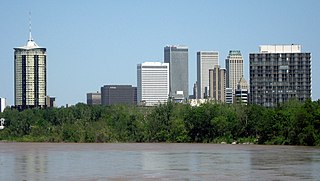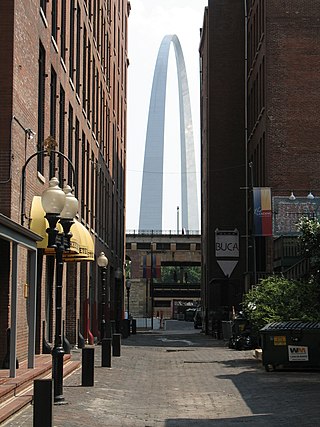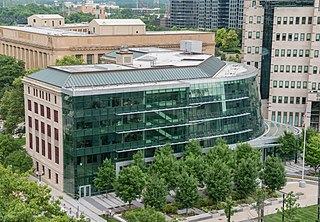
California is a city in and the county seat of Moniteau County, Missouri, United States. As of the 2020 census the population was 4,498. It is the largest city in Moniteau County and the third largest city in the Jefferson City metropolitan area.

The Spanish Colonial Revival style is an architectural stylistic movement arising in the early 20th century based on the Spanish colonial architecture of the Spanish colonization of the Americas.

Miracle Mile is a neighborhood in the city of Los Angeles, California.

Tulsa is the second-largest city in the state of Oklahoma. It has many diverse neighborhoods due to its size.

Pasadena City Hall is the historic city hall of Pasadena, California, United States. Completed in 1927, it combines elements of both Mediterranean Revival and Spanish Colonial Revival style architecture, and is a significant architectural example of the City Beautiful movement of the 1920s.

Downtown Santa Ana (DTSA), also called Downtown Orange County, is the city center of Santa Ana, the county seat of Orange County, California. It is the institutional center for the city of Santa Ana as well as Orange County, a retail and business hub.

The Pasadena Civic Center District is the civic center of and a historic district in Pasadena, California, United States. The district is roughly bounded by Walnut and Green Streets and Raymond and Euclid Avenues.

Charmont Apartments is an historic five-story apartment building in Santa Monica, California which was built in 1928. Designed by architect Max Maltzman with elements of both the Mission Revival-Spanish Colonial Revival style and the Art Deco style, the Charmont was a luxurious high-rise when it was built. The blending of Spanish Colonial Revival and Art Deco elements was popular style in the 1920s and is sometimes known as "Med-Deco." The main entrance is located in a walled courtyard that features a two-tiered fountain with an intricate Moorish-patterned backsplash in polychrome tile.

The Azusa Civic Center is the center of city government in Azusa, California, a city located to the northeast of Los Angeles. The Mission/Spanish Revival buildings were added to the National Register of Historic Places in 2002.

Old Towne, Orange Historic District, also known as Downtown Orange, and colloquially The Circle is a one square-mile district around Plaza Park in Orange, California, and contains many of the original structures built in the period after the city's incorporation. It is a vibrant commercial district, containing Orange County's oldest operating bank. The Historic District was listed on the National Register of Historic Places in 1997, and is the largest National Register District in California. The Old Towne Preservation Association is a non-profit organization dedicated to maintaining the district.

The architecture of St. Louis exhibits a variety of commercial, residential, and monumental architecture. St. Louis, Missouri is known for the Gateway Arch, the tallest monument constructed in the United States. Architectural influences reflected in the area include French Colonial, German, early American, European influenced, French Second Empire, Victorian, and modern architectural styles.

Briarcliff was the mansion and estate of Asa Griggs "Buddy" Candler Jr. (1880–1953), and is now the Briarcliff Campus of Emory University. The estate was built in 1922 on 42 acres on Williams Mill Road, now Briarcliff Road in Druid Hills near Atlanta. Williams Mill Road would be renamed Briarcliff Road in the 1920s after the estate that Asa Jr. would build there. It was listed on the National Register of Historic Places in 1988.

The Greenwich Avenue Historic District is a historic district representing the commercial and civic historical development of the downtown area of the town of Greenwich, Connecticut. The district was listed on the National Register of Historic Places on August 31, 1989. Included in the district is the Greenwich Municipal Center Historic District, which was listed on the National Register the year before for the classical revival style municipal buildings in the core of Downtown. Most of the commercial buildings in the district fall into three broad styles, reflecting the period in which they were built: Italianate, Georgian Revival, and Commercial style. The district is linear and runs north–south along the entire length of Greenwich Avenue, the main thoroughfare of Downtown Greenwich, between U.S. Route 1 and the New Haven Line railroad tracks.

The 28th Street YMCA is a historic YMCA building in South Los Angeles, California. It was listed as a Los Angeles Historic-Cultural Monument in 2006 and put on the National Register of Historic Places in 2009. The four-story structure was built in 1926 at a cost of $200,000. The building was designed by noted African American architect Paul R. Williams in the Spanish Colonial Revival style.

Bimini Baths was a geothermal mineral water public bathhouse and plunge in what is now Koreatown, Los Angeles, California, US. It was situated just west of downtown, near Third Street and Vermont Avenue. Bimini Baths contained a natatorium, swimming pools, swimming plunge, Turkish baths, a medical treatment department, and bottling works.

Columbus City Hall is the city hall of Columbus, Ohio, in the city's downtown Civic Center. It contains the offices of the city's mayor, auditor, and treasurer, and the offices and chambers of Columbus City Council.

The City Hall Park Historic District encompasses one of the central economic, civic, and public spaces of the city of Burlington, Vermont. Centered on City Hall Park, the area's architecture encapsulates the city's development from a frontier town to an urban commercial center. The district was listed on the National Register of Historic Places in 1983.

The David Hall House is a historic house at 25420 W. Cedar Crest Lane in Lake Villa, Illinois. The house was built in 1931 for David and May Cave Hall, a wealthy couple who settled in Lake Villa after taking summer vacations there for many years. Architect Ralph Wesley Varney designed the building in the Art Deco with elements of popular revival styles of the period. An unusual choice for a residential building, the use of Art Deco was likely inspired by May's travels to Hollywood in the 1920s. The house's design includes a rusticated limestone exterior, large Gothic arch windows, a triangular canopy above the entrance, a metal oriel window, and a stepped roof. Its grounds include a swimming pool and terrace garden.

The Columbus Civic Center is a civic center, a collection of government buildings, museums, and open park space in Downtown Columbus, Ohio. The site is located along the Scioto Mile recreation area and historically was directly on the banks of the Scioto River.

77 North Front Street is a municipal office building of Columbus, Ohio, in the city's downtown Civic Center. The building, originally built as the Central Police Station in 1930, operated in that function until 1991. After about two decades of vacancy, the structure was renovated for city agency use in 2011.























